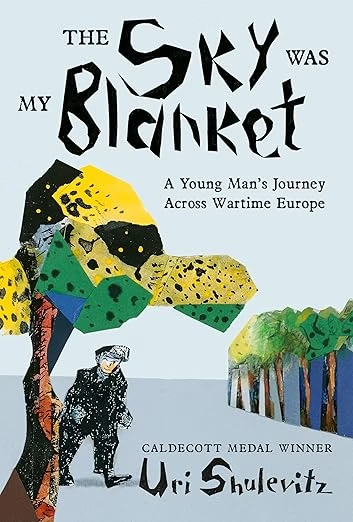The Sky Was My Blanket: A Young Man’s Journey Across Wartime Europe
Uri Shulevitz
Farrar, Straus, & Giroux
Published August 12, 2025
Amazon | Bookshop | Goodreads
About The Sky Was My Blanket
From celebrated Caldecott Award–winning illustrator Uri Shulevitz comes the gripping and revealing true story of a young Polish exile fighting to survive in war-torn Europe.
Born in the tumult of World War I, a young Jewish boy named Yehiel Szulewicz chafes at the borders of his hometown of Żyrardów, Poland, and at the rules set in place by his restrictive parents. Brimming with a desire for true adventure, he leaves home at fifteen-and-a-half years old to seek his future elsewhere. Little does Yehiel know, he’ll never see his parents again.
His journey takes him beyond Polish borders, to Austria, Croatia, France, and Spain. With no money and no ID papers, he often sleeps under the stars, with only the sky as his blanket. But even wayfaring Yehiel can’t outrun the evil spreading across Europe in the years leading up to World War II. As the fascists and Nazis rise to power, Yehiel soon finds himself a member of the Spanish Republican Army and then the Jewish Resistance in Vichy France, fighting for freedom, his friends, and his very life.
Inspired by the true story of Uri Shulevitz’s uncle and stunningly illustrated by the author, The Sky Was My Blanket is a unique and riveting account of one man’s courage and resilience amidst one of the darkest periods in global history.
Don’t miss Uri Shulevitz’s acclaimed memoir, Chance: Escape from the Holocaust: Memories of a Refugee Childhood, which bestselling author Elizabeth Wein called “harrowing, engaging and utterly honest” (New York Times Book Review).
My Review
I really liked the way this book was written. Each part is broken into very short chapters, usually only a page or so of text, often accompanied by a drawing. This allows the story to focus on the critical moments of Yeheil’s journey. It feels exactly like the snippets you might get when you sit down to ask a relative to tell their life story.
It’s also the kind of information that you’d tell an interested child if you were relating your experiences, so it doesn’t delve too deeply into the horrors of war that Yeheil must have witnessed.
Many of the World War II stories that I’ve read following Jewish characters relate experiences in Concentration Camps, and those are critically important stories to tell. (Perhaps only more important now.) Still, this narrative reminds readers that those aren’t the only experiences of war survivors.
I haven’t read Uri Shulevitz’s memoir, Chance: Escape from the Holocaust: Memories of a Refugee Childhood but after reading his account inspired by his uncle’s life, it’s high on my reading list.
Content Notes
Recommended for Ages 10 to 14.
Profanity/Crude Language Content
None.
Romance/Sexual Content
Reference to marriage.
Spiritual Content
Reference to Jewish faith and traditions.
Violent Content
Situations of peril. Reference to ghettos and concentration camps.
Drug Content
None.
Note: This post contains affiliate links, which do not cost you anything to use but help support this blog. I received a free copy of this book in exchange for my honest review. All opinions are my own.
Marvelous Middle-Grade Monday
I’m sharing this post as a part of a weekly round-up of middle-grade posts called Marvelous Middle-Grade Monday. Check out other blogs with posts about middle-grade books today on Marvelous Middle-Grade Mondays at Always in the Middle.
